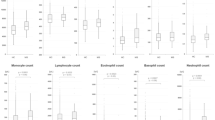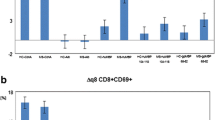Summary
The influence of disease activity on blood cell counts was studied in over 100 multiple sclerosis patients examined at regular intervals of 4–8 weeks over an 18-month period. T-lymphocytes were assessed by the cytochemical α-naphthyl-acetate-esterase (ANAE) stain in addition to conventional differentials. In all patients as a group as well as in individual patients studied sequentially, an exacerbation was marked by a striking reduction in both the relative and absolute numbers of ANAE-positive cells. Simultaneously, a strong increase in granulocytes and a slight augmentation of ANAE-negative cells occurred. Similar changes related to disease activity in leucocytes and lymphocytes were also detected in conventional blood smears. Fluctuations in the number of blood cells with disease activity persisted under therapy with corticosteroids and to a lesser degree also with azathioprine.
Zusammenfassung
Bei über 100 Multiple-Sklerose-Kranken wurde im Verlauf von eineinhalb Jahren in möglichst regelmäßigen Abständen von 4–8 Wochen untersucht, ob und inwieweit die Krankheitsaktivität das Blutbild beeinflußt. Dabei wurde speziell das Verhalten der T-Lymphozyten mit Hilfe der α-Naphthylacetatesterase-Färbung studiert. Kranke im Schub hatten eine deutliche und Kranke im Stadium der Progression eine leicht verminderte Anzahl von T-Lymphozyten, und zwar nicht nur relativ, sondern auch absolut. Umgekehrt war im Krankheitsschub die absolute Anzahl der Granulozyten stark, die der ANAE-negativen Lymphozyten gering vermehrt. Auch im Krankheitsverlauf schwankte die Zahl der genannten Zellen in Abhängigkeit von der Krankheitsaktivität. Die Zahl der T-Lymphozyten nahm deutlich ab, wenn sich ein Schub einstellte, auch dann, wenn er sich einem schon progredienten Verlauf aufpfropfte. Zugleich nahm die Zahl der Granulozyten und ANAE-negativen Lymphozyten zu. Im konventionellen Blutbild spiegelten sich diese Veränderungen in der Leukozytenzahl und der relativen Anzahl der Lymphozyten ebenfalls deutlich wieder. Diese von der Aktivität der Krankheit abhängige Fluktuation der Blutbestandteile wurde nur zum Teil hervorgerufen durch die Therapie mit Prednison und/oder Azathioprin. Kortikosteroide und Azathioprin hatten gegensinnige Wirkungen auf die Anzahl der Granulozyten. Bei Azathioprinbehandelten waren die Unterschiede in der Anzahl der Blutzellen zwischen Krankheitsschub und Intervall am geringsten.
Similar content being viewed by others
References
Abb L, Schaltenbrand G (1956) Statistische Untersuchungen zum Problem der Multiplen Skerose. Dtsch Z Nervenheilkd 174:199–218
Antel JP, Arnason EGW, Medof ME (1979) Suppressor cell function in multiple sclerosis: correlation with clinical disease activity. Ann Neurol 5:338–342
Antel J, Oger JJF, Jackevicius S, Kuo HH, Arnason BGW (1982) Modulation of T-lymphocyte differentiation antigens: potential relevance for multiple sclerosis. Proc Natl Acad Sci 79:3330–3334
Armitage JR, Linch DC, Worman CP, Cawley JC (1982) The morphology and cytochemistry of human T-cell subpopulations defined by monoclonal antibodies and Fc receptors. Br J Haematol 51:605–613
Bach MA, Phan-Dinh-Tuy F, Tournier E, Chatenoud L, Bach JF (1980) Deficit of suppressor T-cells in active multiple sclerosis. Lancet II:1221–1224
Bergroth V, Konttinen YT, Reitamo S (1983) A method for the identification of human peripheral blood T lymphocytes by segmential immuno gold and esterase double staining. J Histochem Cytochem 31:837–839
Beutel P, Küffner H, Schubö W (1980) Statistik-Programm. System für die Sozialwissenschaften nach NH Nie und CH Hull, 3. Aufl. Fischer, Stuttgart New York, S 156–168
Czlonkowska A, Póltorak M, Cendrowski W, Korlak J (1980) Lymphocyte subpopulations in the cerebrospinal fluid and peripheral blood in multiple sclerosis. Acta Neurol Scand 62:55–62
Dommasch D, Weckerle H (1983) T lymphocyte subpopulations in multiple sclerosis and other neurological disease. Max-Planck-Society, Clinical research unit for multiple sclerosis. Annual report
Goust JM, Chenais F, Carnes JE, Hames CG, Fudenberg HH, Hogan EL (1978) Abnormal T-cell subpopulations and circulating immune complexes in the Guillain-Barré syndrome and multiple sclerosis. Neurology (Minneap) 28:421–425
Hauser SL, Reinherz EL, Hoban CJ, Schlossman SF, Weiner HL (1983) Immunoregulatory T-cells and lymphocytotoxic antibodies in active multiple sclerosis: weekly analysis over a six-month period. Ann Neurol 13:418–425
Haynes BF, Fauci AS (1978) The differential effects of in vivo hydrocortisone on the kinetics of subpopulations of human peripheral blood thymus-derived lymphocytes. J Clin Invest 61:703–707
Huddlestone JR, Oldstone MBA (1979) T suppressor (Tg) lymphocytes fluctuate in parallel with changes in the clinical course of patients with multiple sclerosis. J Immunol 123:1615–1618
Kaschka WP, Hilgers R (1980) Blood lymphocyte subpopulations show characteristic changes during ACTH therapy in acute exacerbations of multiple sclerosis. Acta Neurol Scand 61:275–286
Lisak RP, Levinson AI, Zweiman B, Abdou NI (1975) T and B lymphocytes in multiple sclerosis. Clin Exp Immunol 22:30–34
Manconi PE, Marrosu MG, Paghi L, Correale G, Zaccheo D (1979) Alpha-naphthyl acetate esterase activity in human lymphocytes: distribution in lymphocyte subpopulations and in mitogen-activated cells. Scand J Immunol 9:99–104
Manconi PE, Marrosu MG, Cianchetti C, Ennas MG, Mangoni A, Zaccheo D (1980) Lymphocyte subpopulations in cerebrospinal fluid and peripheral blood in multiple sclerosis. Acta Neurol Scand 62:165–175
McFarlin DE, McFarland HF (1982) Multiple sclerosis. N Engl J Med 307:1183–1188, 1246–1251
Naess A, Nyland H (1978) Multiple sclerosis: T lymphocytes in cerebrospinal fluid and blood. Eur Neurol 17:61–66
Naess A, Nyland H (1981) Effect of ACTH treatment on CSF and blood lymphocyte subpopulations in patients with multiple sclerosis. Acta Neurol Scand 63:57–66
Nie N, Bent DH, Hull C (1975) Statistical package for the social sciences. McGraw-Hill, New York
Oger JF, Arnason BGW, Wray SH, Kistler JP (1975) A study of B and T cells in multiple sclerosis. Neurology (Minneap) 25:444–447
Oger JJF, Antel JP, Kuo HH, Arnason BGW (1982) Influence of azathioprine (Imuran) on in vitro immune function in multiple sclerosis. Ann Neurol 11:177–181
Paty DW, Kastrukoff LF, Hiob L (1981) Chronic progressive multiple sclerosis has low suppressor cell levels. Ann Neurol 10:97
Patzold U, Hecker H, Pocklington P (1982) Azathioprine in treatment of multiple sclerosis. J Neurol Sci 54:377–394
Pichler WJ, Lange M-L, Birke C, Peter HH (1982) Relationship of Fc-IgG and Fc-IgM receptors to the antigens defined by OKT-antibodies and the acid α-naphthyl-acetate-esterase spot within human T-cells. Immunobiology 160:424–437
Poser CM (1980) Exacerbations, activity and progression in multiple sclerosis. Arch Neurol 37:471–474
Ranki A (1978) Nonspecific esterase activity in human lymphocytes. Clin Immunol Immunopathol 10:47–58
Reinherz EL, Weiner HL, Hauser SL, Cohen JA, Distaso JA, Schlossmann SF (1980) Loss of suppressor T cells in active multiple sclerosis. Analysis with monoclonal antibodies. N Engl J Med 303:125–129
Robinson BN, Anderson GD, Cohen E, Gazdzik WF, Karpel LL, Miller AH, Stein JR (1980) Sir scientific information retrieval user's manual, version 2. Sir Inc, PO Box 1404, Evanston, IL 60204
Santoli D, Trinchieri G, Koprowski H (1978) Cell mediated cytotoxicity against viruses-infected target cells in humans. II. Interferon induction and activation of natural killer cells. J Immunol 121:532–538
Schumacher GA, Beebe G, Kibler RF, Kurland LT, Kurtzke JF, Dowell FM, Nagler B, Sibley WA, Tourtelotte WW, Willmon TL (1965) Problems of experimental trials of therapy in multiple sclerosis. Report by the panel on the evaluation of experimental trials of therapy in multiple sclerosis. Ann NY Acad Sci 122:552–568
Trotter JL, Garvey WF (1980) Prolonged effects of large-dose methylprednisolone infusion in multiple sclerosis. Neurology (Minneap) 30:702–708
Trotter JL, Rodey GE, Gebel HM (1982) Azathioprine decreases suppressor T cells in patients with multiple sclerosis. N Engl J Med 306:365–366
Wallen WC, Houff SA, Iivanainen M, Calabrese VP, De Vries GH (1981) Suppressor cell activity in multiple sclerosis. Neurology (NY) 31:668–674
Weiner HL, Schocket AL (1979) Lymphocytes in multiple sclerosis. Correlation with CSF immunoglobulins and cold-reactive lymphocytotoxic antibodies. Neurology (Minneap) 29:1504–1508
Wurster W, Patzold U (1982) Long-term treatment of multiple sclerosis with azathioprine. Effects on cerebrospinal fluid parameters. In: Hommes OR (ed) Workshop on immunosuppressive treatment in multiple sclerosis, Nijmegen
Author information
Authors and Affiliations
Additional information
This study was supported by the Hertie Foundation
Rights and permissions
About this article
Cite this article
Patzold, U., Wurster, U., Mardt, K. et al. The influence of disease activity on the number of blood cells of multiple sclerosis patients. J Neurol 231, 26–33 (1984). https://doi.org/10.1007/BF00313648
Received:
Issue Date:
DOI: https://doi.org/10.1007/BF00313648




